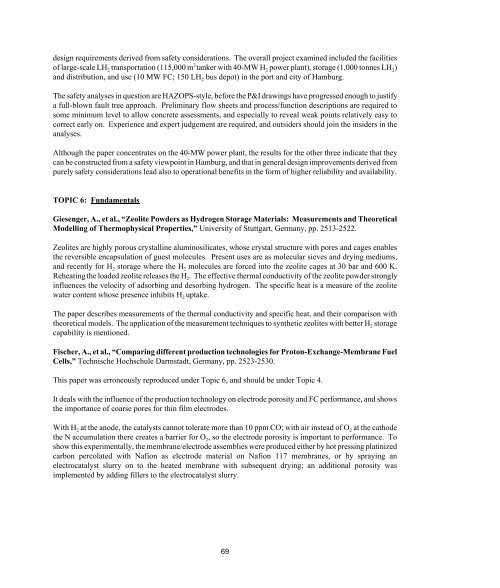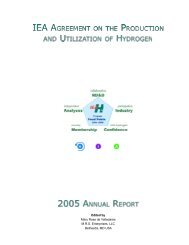Technology Status of Hydrogen Road Vehicles
Technology Status of Hydrogen Road Vehicles
Technology Status of Hydrogen Road Vehicles
You also want an ePaper? Increase the reach of your titles
YUMPU automatically turns print PDFs into web optimized ePapers that Google loves.
design requirements derived from safety considerations. The overall project examined included the facilities<br />
<strong>of</strong> large-scale LH 2 transportation (115,000 m 3 tanker with 40-MW H 2 power plant), storage (1,000 tonnes LH 2)<br />
and distribution, and use (10 MW FC; 150 LH 2 bus depot) in the port and city <strong>of</strong> Hamburg.<br />
The safety analyses in question are HAZOPS-style, before the P&I drawings have progressed enough to justify<br />
a full-blown fault tree approach. Preliminary flow sheets and process/function descriptions are required to<br />
some minimum level to allow concrete assessments, and especially to reveal weak points relatively easy to<br />
correct early on. Experience and expert judgement are required, and outsiders should join the insiders in the<br />
analyses.<br />
Although the paper concentrates on the 40-MW power plant, the results for the other three indicate that they<br />
can be constructed from a safety viewpoint in Hamburg, and that in general design improvements derived from<br />
purely safety considerations lead also to operational benefits in the form <strong>of</strong> higher reliability and availability.<br />
TOPIC 6: Fundamentals<br />
Giesenger, A., et al., “Zeolite Powders as <strong>Hydrogen</strong> Storage Materials: Measurements and Theoretical<br />
Modelling <strong>of</strong> Thermophysical Properties,” University <strong>of</strong> Stuttgart, Germany, pp. 2513-2522.<br />
Zeolites are highly porous crystalline aluminosilicates, whose crystal structure with pores and cages enables<br />
the reversible encapsulation <strong>of</strong> guest molecules. Present uses are as molecular sieves and drying mediums,<br />
and recently for H 2 storage where the H 2 molecules are forced into the zeolite cages at 30 bar and 600 K.<br />
Reheating the loaded zeolite releases the H 2. The effective thermal conductivity <strong>of</strong> the zeolite powder strongly<br />
influences the velocity <strong>of</strong> adsorbing and desorbing hydrogen. The specific heat is a measure <strong>of</strong> the zeolite<br />
water content whose presence inhibits H 2 uptake.<br />
The paper describes measurements <strong>of</strong> the thermal conductivity and specific heat, and their comparison with<br />
theoretical models. The application <strong>of</strong> the measurement techniques to synthetic zeolites with better H 2 storage<br />
capability is mentioned.<br />
Fischer, A., et al., “Comparing different production technologies for Proton-Exchange-Membrane Fuel<br />
Cells,” Technische Hochschule Darmstadt, Germany, pp. 2523-2530.<br />
This paper was erroneously reproduced under Topic 6, and should be under Topic 4.<br />
It deals with the influence <strong>of</strong> the production technology on electrode porosity and FC performance, and shows<br />
the importance <strong>of</strong> coarse pores for thin film electrodes.<br />
With H 2 at the anode, the catalysts cannot tolerate more than 10 ppm CO; with air instead <strong>of</strong> O 2 at the cathode<br />
the N accumulation there creates a barrier for O 2, so the electrode porosity is important to performance. To<br />
show this experimentally, the membrane/electrode assemblies were produced either by hot pressing platinized<br />
carbon percolated with Nafion as electrode material on Nafion 117 membranes, or by spraying an<br />
electrocatalyst slurry on to the heated membrane with subsequent drying; an additional porosity was<br />
implemented by adding fillers to the electrocatalyst slurry.<br />
69













